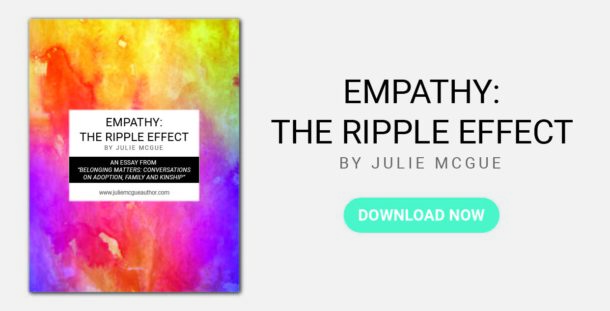Ancestry Test Kits

Julie McGue
Author
The two major companies selling ancestry service kits are offering great deals for the holidays. My kids and their significant others will all receive one in their stockings this year. The New York Times Magazine ran a special section recently called “Secrets & Genes”. The subheading was compelling: “The surge in popularity of services like 23nMe and Ancestry means that more and more people are unearthing long-buried connections and surprises in their ancestry.” From my experience, this statement is right on the mark.
I am adopted. I am also a twin. I can’t remember the day my folks shared with my sister and me that we were the offspring from another woman’s womb. Being adopted wasn’t ever a secret. My parent’s have always said that one of the most important moments in their lives was the day they got the call from Catholic Charities in Chicago to come pick up their fraternal twin daughters.
About eight years ago, I experienced some health issues and my husband encouraged me to talk to my folks, look into my adoption, and gather some medical history. At that time DNA test kits were out of my budget. Untangling a closed adoption in Illinois became easier once the state adoption statutes changed in 2011. However, in my case my birthmother had used an alias, so we encountered several years of roadblocks. If the test kits had been more affordable and the adoption laws more amenable, perhaps we wouldn’t have had to wait so long to determine our ancestry, but patience did win out.
About four years ago, the ancestry service kits started to come down in price and my sister and I signed up. Shortly thereafter, both my twin and me started to receive links to relatives. That was exciting! It was still early in the ancestry services game, so without legitimate birth family names, we couldn’t determine if our new third and fourth cousins were maternal or paternal. One aspect of the test did change the way my sister and I came to think about the adoption information we’d been given.
Early in 2010, our birth mother had been located but denied contact with us. As a birthday gift my sister’s family gave her a 23nMe test kit. She encouraged me to try it too. So I forked out the fee and sent off my spit. Just for fun I selected the twin studies option. My parents had been told by the adoption agency that we were fraternal, but strangers and family had been mixing us up for ages. With the exception of different hairstyles, we looked more identical than fraternal. For you biology challenged adults, fraternal means two eggs are fertilized by separate sperm and thrive in two placentas. Identical twins are a result of one egg being fertilized by one sperm, splitting and maturing in one placenta. Pretty easy to tell what’s up if the hospital conveys the news properly to the parents or adopting agency.
In our case, our birth mother didn’t know she was pregnant with twins until after our births (it was almost sixty years ago, and unwed mothers didn’t receive the same prenatal care as married women back in the 1950s). She never saw us, never held us, just signed some papers and disappeared (No tears: spoiler alert- a reunion does happen). She was simply told she had twins. As I said, our adoptive parents told us were fraternal and it wasn’t until the 23nMe results hit my inbox did my sister and me learn otherwise.
We are identical twins! Thanks to the DNA test kits, the controversy over why my sister and me looked alike but were fraternal was settled, but other items turned up in our testing. Besides learning the origins of our ancestors (France, Germany, Scotland and Ireland), we learned that we are Native American. Upon meeting our birth relatives we discovered the paternal line has Chippewa while Cree appears in our maternal line. Too late to use that on a college application but incredibly interesting nonetheless.
What I love about subscribing to these sites, Ancestry & 23nMe, is not just the ancestry composition, it is the opportunity to link with relatives. There are more and more first and second-generation relatives showing up on my profile every month. Because the testing is affordable, it is growing in popularity. For an adoptee that means my bona fide biological family tree is finally filling out. As I approach sixty, this thrills me.
So get on the bandwagon, and sign up. You never know who will show up in your inbox. You might discover a relative that was switched at birth, or a first cousin in the same city born out of wedlock to your Aunt Sally. You might even discover a health issue that you will be glad you got the heads-up on before it is a problem. Even if you are not adopted, learning everything you can about yourself is liberating and rewarding.
“Even if you are not adopted, learning everything you can about yourself is liberating and rewarding.”

Snag my in-depth reference guide to best equip you for the journey ahead.


0 Comments